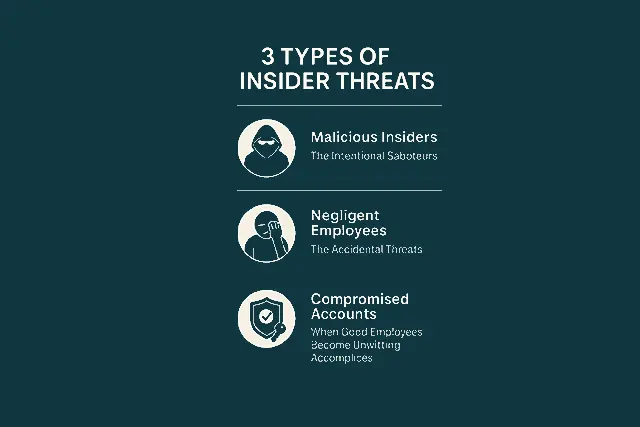Insider Threat Attacks: The Enemy Within Your Organization

The most damaging insider threat attacks I’ve investigated turned out to be a trusted IT administrator who sold access credentials to competitors for $50,000. What made this case particularly devastating wasn’t just the financial loss it was the complete erosion of trust within the organization. This scenario plays out more often than you’d think, with insider threat attacks causing an average of $15.4 million in damages per incident according to the 2024 Ponemon Institute report.
Table of Contents
Understanding the Three Types of Insider Threat Attacks
Not all insider threat attacks stem from malicious intent. Understanding the different categories helps organizations build more effective employee cyber security threats prevention strategies.
Malicious Insiders: The Intentional Saboteurs
Malicious insiders actively seek to harm their organization. These insider threat attacks often involve employees who feel wronged or see an opportunity for personal gain. Recent FBI statistics show that 23% of internal security breaches involve employees with malicious intent.
Common motivations include:
- Financial gain through selling company secrets
- Revenge for perceived workplace injustices
- Ideological differences with company policies
- Recruitment by competitors or foreign entities
Negligent Employees: The Accidental Threats
What surprised me about insider threat attacks is how often they’re not malicious at all. Negligent employees cause 62% of employee cyber security threats through careless actions like:
- Falling for phishing emails that compromise credentials
- Using weak passwords across multiple systems
- Sharing login information with colleagues
- Bypassing security protocols for convenience
These internal security breaches often result from inadequate training rather than ill intent. Workplace security monitoring data shows that most negligent insiders repeat risky behaviors simply because they don’t understand the consequences.
Compromised Accounts: When Good Employees Become Unwitting Accomplices
The third category involves legitimate users whose accounts are hijacked. These insider threat attacks blur the line between internal and external threats. Attackers use stolen credentials to move laterally through networks, making insider threat detection particularly challenging.
Warning Signs: Behavioral Indicators of Potential Insider Threats
Identifying potential insider threat attacks before they occur requires understanding behavioral patterns. Through workplace security monitoring and observation, security teams can spot these red flags:
Technical Indicators
- Accessing systems outside normal working hours
- Downloading unusually large amounts of data
- Using unauthorized USB devices or cloud storage
- Attempting to access restricted areas of the network
- Disabling or circumventing security software
Behavioral Changes
- Sudden lifestyle changes beyond known income
- Expressing dissatisfaction with company policies
- Discussing new job opportunities while accessing sensitive data
- Becoming defensive about employee access controls
- Working odd hours without clear business justification
According to CISA’s comprehensive insider threat framework, these behavioral indicators become particularly concerning when multiple signs appear simultaneously. Their research shows that 92% of insider threat attacks involve at least three observable warning signs before the incident occurs.
Digital Footprints
Modern insider threat detection tools can identify:
- Unusual email patterns to personal accounts
- Increased printing of sensitive documents
- Multiple failed login attempts to restricted systems
- Use of encryption tools not approved by IT
- Accessing competitor websites during work hours
Technical Controls: Building Your Defense Against Internal Security Breaches
Preventing employee cyber security threats requires layered technical controls that balance security with productivity. Here’s what works:
Principle of Least Privilege
Implementing strict employee access controls ensures users only access what they need. This approach limits potential damage from insider threat attacks by:
- Segmenting network access based on roles
- Requiring multi-factor authentication for sensitive systems
- Implementing time-based access for contractors
- Regular access reviews and immediate revocation upon termination
Data Loss Prevention (DLP) Systems
DLP solutions are crucial for preventing internal security breaches. They monitor and control data movement by:
- Blocking unauthorized file transfers
- Alerting on suspicious download patterns
- Encrypting sensitive data automatically
- Tracking document access and modifications
User Activity Monitoring
Workplace security monitoring has evolved beyond simple keystroke logging. Modern solutions provide:
- Real-time alerts for anomalous behavior
- Screen recording for high-risk activities
- Integration with HR systems for context
- Predictive analytics for insider threat detection
The CERT Insider Threat Center at Carnegie Mellon has developed advanced methodologies showing that behavioral monitoring combined with technical controls reduces insider threat attacks by up to 47% when properly implemented.

HR Policies and Procedures: The Human Side of Prevention
Technical controls alone can’t prevent insider threat attacks. HR departments play a crucial role in addressing employee cyber security threats through comprehensive policies.
Pre-Employment Screening
Thorough background checks remain the first line of defense against internal security breaches. Effective screening includes:
- Criminal history verification
- Employment and education confirmation
- Credit checks for financial positions
- Reference checks focusing on integrity
- Social media assessment where legally permitted
Ongoing Employee Monitoring
Workplace security monitoring must balance security needs with privacy rights. Key considerations include:
- Clear policies communicated during onboarding
- Regular security awareness training
- Anonymous reporting mechanisms
- Periodic re-screening for sensitive positions
- Exit procedures that protect company assets
Creating a Security-Conscious Culture
Preventing insider threat attacks requires employee buy-in. Successful programs:
- Reward security-conscious behavior
- Provide clear escalation paths for concerns
- Address the root causes of employee dissatisfaction
- Include security metrics in performance reviews
- Celebrate caught attempts as learning opportunities
Legal Considerations: Navigating Employee Privacy Rights
The legal challenges of monitoring employees while respecting privacy create complex scenarios for preventing employee cyber security threats. US employment law adds layers of complexity that organizations must navigate carefully.
Federal and State Requirements
Workplace security monitoring must comply with:
- Electronic Communications Privacy Act (ECPA)
- State-specific privacy laws (California’s particularly strict)
- NLRB guidelines on employee monitoring
- Industry-specific regulations (HIPAA, SOX, etc.)
Best Practices for Legal Compliance
To implement employee access controls and monitoring legally:
- Obtain written consent before monitoring
- Clearly define what will be monitored
- Limit monitoring to business-related activities
- Store monitoring data securely
- Establish retention and deletion policies
Union Considerations
For unionized workplaces, insider threat detection programs must:
- Include union representatives in policy development
- Address monitoring in collective bargaining
- Ensure disciplinary actions follow agreed procedures
- Balance security needs with worker rights
Real-World Case Studies: Learning from Internal Security Breaches
Understanding how insider threat attacks unfold in real organizations provides valuable lessons for prevention.
Case 1: The Departing Developer
A software company discovered internal security breaches when a developer uploaded proprietary code to GitHub before joining a competitor. Employee access controls failed because:
- Access wasn’t revoked during notice period
- Code repositories lacked proper classification
- DLP tools weren’t configured for developer workflows
The incident cost $3.2 million in competitive advantage and legal fees.
Case 2: The Compromised CFO
Employee cyber security threats materialized when a CFO’s credentials were stolen through a targeted phishing attack. The attackers used these credentials to initiate fraudulent wire transfers. Insider threat detection eventually caught the suspicious activity, but not before $750,000 was transferred.
Case 3: The Negligent Contractor
A contractor’s failure to follow workplace security monitoring protocols led to insider threat attacks when their unencrypted laptop was stolen. The device contained sensitive customer data, resulting in:
- $4.5 million in breach notification costs
- Loss of three major clients
- 18-month regulatory investigation
- Significant reputational damage
Building Your Insider Threat Program: A Practical Roadmap
Creating an effective defense against internal security breaches requires a structured approach:
Phase 1: Assessment and Planning (Months 1-2)
- Identify critical assets and potential insider threats
- Review current employee access controls
- Assess legal and cultural constraints
- Define program objectives and metrics
Phase 2: Policy Development (Months 2-3)
- Create comprehensive insider threat policies
- Develop workplace security monitoring guidelines
- Establish incident response procedures
- Design training programs
Phase 3: Technical Implementation (Months 3-6)
- Deploy insider threat detection tools
- Implement DLP and monitoring solutions
- Configure employee access controls
- Integrate with existing security infrastructure
Phase 4: Ongoing Operations (Month 6+)
- Monitor for employee cyber security threats
- Conduct regular program reviews
- Update policies based on lessons learned
- Maintain employee awareness and training
When Prevention Fails: Responding to Insider Incidents
Despite best efforts, insider threat attacks may still occur. When they do, proper response is critical. As detailed in our comprehensive incident response guide, insider threat incidents require special procedures that differ from external attacks.
The response must balance:
- Immediate containment of the threat
- Preservation of evidence for legal action
- Minimal disruption to operations
- Protection of the investigation’s integrity
- Employee morale and trust considerations
The Human Factor: Why Traditional Security Isn’t Enough
Internal security breaches often succeed because they exploit trust the foundation of any productive workplace. When social engineering turns employees into insider threats, traditional perimeter security becomes irrelevant.
Consider these statistics:
- 88% of insider threat attacks involve users with legitimate access
- Average detection time for employee cyber security threats: 77 days
- 67% of organizations lack formal insider threat programs
- Only 42% of companies monitor for internal security breaches
Future-Proofing Your Organization Against Evolving Threats
As remote work becomes permanent for many organizations, insider threat attacks are evolving. New challenges include:
- Monitoring distributed workforces
- Securing personal devices used for work
- Detecting threats across cloud applications
- Maintaining security culture without face-to-face interaction
Workplace security monitoring must adapt to these realities while respecting the increased privacy expectations of remote workers. Employee access controls need to be dynamic, adjusting based on location, device, and behavior patterns.
Frequently Asked Questions About Insider Threat Attacks
What percentage of data breaches involve insider threats?
According to recent studies, approximately 34% of all data breaches involve insider threat attacks. This includes both malicious and negligent insiders, with employee cyber security threats costing organizations an average of $15.4 million per incident.
How long does it typically take to detect insider threats?
The average detection time for internal security breaches is 77 days. However, organizations with mature insider threat detection programs can reduce this to under 30 days through proper workplace security monitoring and behavioral analytics.
Are insider threats always malicious?
No, the majority (62%) of insider threat attacks are actually caused by negligent employees rather than malicious intent. These employee cyber security threats often result from inadequate training, carelessness, or failure to follow security protocols.
What’s the most common type of insider threat?
Data theft represents 45% of all insider threat attacks, followed by sabotage (23%), fraud (20%), and espionage (12%). Internal security breaches involving intellectual property theft are particularly damaging for technology companies.
Can small businesses implement insider threat programs?
A: Yes, even small organizations can implement basic insider threat detection measures. Start with fundamental employee access controls, clear policies, and basic workplace security monitoring. Scale your program as your organization grows.
How do insider threat programs handle employee privacy?
A: Effective programs balance security with privacy through transparent policies, limited monitoring scope, and compliance with federal and state laws. Workplace security monitoring should focus on business-related activities only, with clear employee consent.
What’s the ROI of insider threat prevention programs?
Organizations with mature insider threat programs report an average ROI of 3:1, primarily through prevented internal security breaches and reduced incident response costs. The investment in employee access controls and monitoring typically pays for itself within 18 months.
Taking Action: Your Next Steps
Protecting against insider threat attacks isn’t optional it’s essential for organizational survival. Start by:
- Conducting an insider threat risk assessment
- Reviewing and updating employee access controls
- Implementing basic workplace security monitoring
- Training HR and IT teams on insider threat detection
- Creating clear policies for internal security breaches
Remember, this often overlooked category in comprehensive attack defense requires ongoing attention. Employee cyber security threats will continue evolving, but with proper preparation, your organization can stay ahead of the threat.
The enemy within doesn’t have to win. By understanding insider threat attacks, implementing proper controls, and maintaining vigilance, you can protect your organization from its most dangerous vulnerability the trusted insider who goes rogue.







